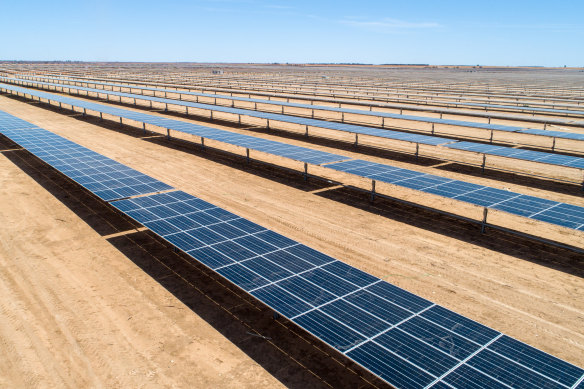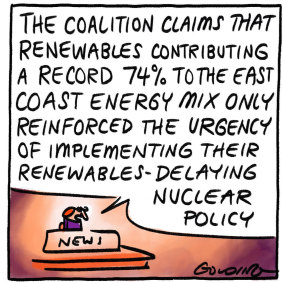Renewables’ half-hour of power on the east coast
By Nick Toscano
Australia’s clean energy transition notched a record this week as renewables surged to an all-time high of nearly 74 per cent of the entire east-coast electricity mix during a half-hour period, pushing fossil fuels to a new low.
Between 11.30am and midday on Tuesday, the contribution from millions of rooftop solar panels and large-scale renewable energy assets was the highest it’s ever been, the Australian Energy Market Operator (AEMO) said.

Renewable energy is expanding across Australia, but the transition is still running behind schedule.
“A new peak renewable output record of 73.87 per cent was set … at 11.30am in the national electricity market,” it said.
At the time, generation across the interstate grid that runs up the eastern seaboard consisted of 43.1 per cent from rooftop solar, 19.8 per cent from solar farms and 8.6 per cent from wind turbines, AEMO said.
Power stations that burn coal or natural gas to produce electricity sank to 26.1 per cent – their lowest-ever contribution in a 30-minute interval.
The record-breaking half an hour for renewable energy marks another milestone in Australia’s transition from heavy-emitting fossil fuels to cleaner sources of energy.
The share of power generated from the sun, wind and water is expanding each year in Australia as billions of dollars pour into household and grid-scale renewable energy and batteries, while the polluting coal-fired generators that supply the bulk of the nation’s electricity increasingly bring forward their closure dates.
However, build-out of renewable generation and storage, and the thousands of kilometres of new power lines to link them to major cities, is still lagging the speed that experts say is required for Australia to achieve its 2030 greenhouse gas emissions targets. It is also falling short of the rate officials deem necessary to compensate for the next wave of coal-fired generator closures without heightening the risk to consumers of power shortages or price spikes.
Dylan McConnell, an energy systems analyst at UNSW, said the grid’s record-breaking bursts of instantaneous renewable energy were “good markers of progress and should be celebrated”.
But the increase in the average share of renewable energy across the past year “tells less of a positive story”, he said.
Renewable energy had a 38.9 per cent share of the electricity mix in the past three months, which was only slightly higher than the 38.7 per cent it had in the same quarter of 2023, he said.
“We are moving forward, it is happening, just not as fast as we need it to be,” McConnell said.
“The thing that matters for emissions and the energy transition is the overall, annual number.”
The Albanese government is aiming to double the share of renewable energy to at least 82 per cent by 2030 as part of its commitment to cutting national emissions by 43 per cent on 2005 levels and reaching net zero by 2050.

Credit: Matt Golding
While a growing number of experts and industry players believe Australia is set to fall short of that goal, McConnell believes it may still be reachable depending on the speed and scale of the delivery of new renewable generation and storage projects under the government’s plan to turbocharge the financing of new projects, known as the Capacity Investment Scheme.
The underwriting scheme targets the construction of 23 gigawatts of renewable energy generation by the end of the decade, as well as nine gigawatts of additional “dispatchable” assets, such as batteries and pumped hydro, which can store clean energy and provide it to the grid at times when the sun goes down and the wind disappears.
“It’s possible that people are being too pessimistic,” McConnell said.
The Business Briefing newsletter delivers major stories, exclusive coverage and expert opinion. Sign up to get it every weekday morning.